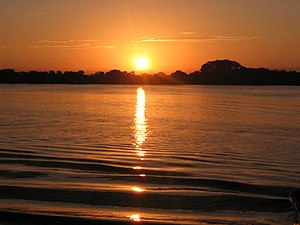Pantanos de Centla
The Pantanos de Centla (Spanish: pantano = 'swamp') are a large swamp area in the common estuary of the Río Usumacinta and the Rio Grijalva in the state of Tabasco in southeastern Mexico . Since 1992 the area has been designated as a biosphere reserve and placed under protection; it is on a list of proposals for recognition as a UNESCO World Heritage Site .
geography
The Pantanos de Centla were created through millennia-long earth and sand deposits of the three estuary of the Rio Usumacinta and its tributaries, especially the Río Grijalva. The swampy alluvial land is on average only about 10 meters above sea level and has an area of about 300,000 hectares - it makes up about 12.3% of the total area of the state of Tabasco.
climate
The climate is subtropical and humid with an average temperature of 25.9 °. Most of the rain falls in the winter months and in May and June; In March / April and July / August it is usually comparatively dry.
flora
Reeds , mangroves and other aquatic plants such as water hyacinths ( Eichhornia crassipes ), duckweed ( Lemna minor ), water lilies ( Nymphaea odorata ) etc. make up the largest part of the flora; In addition, there are palm trees such as the guano palm ( sabal mexicana ), but there are also smaller areas used for agriculture.
Reed ( Typha latifolia )
Duckweed ( Lemna minor )
Guano palm ( Sabal mexicana )
fauna
The marshland of the Pantanos de Centla is one of the last largely natural habitats for various crocodile , iguana and turtle species , etc.But above all birds - including the Jabiru, which is rarely found in Mexico, as well as various heron species , osprey and peregrine falcon - find food ( fish , Frogs , lizards etc.) and breeding sites in the reserve. Mammals include: howler monkeys , spider monkeys , jaguars , ocelots , agoutis , manatees and various small mammals . Among the many species of fish, the bone pike , which is only known in America, should be emphasized.
history
So far, archaeologists have discovered 19 places in the swamps that indicate settlement as early as 1500 BC. Point out. However, only sparse remains of (imported?) Ceramic shards have been found, as there is no stone material in the alluvial land of the Pantanos .
population
Although there are no major settlements in the Pantanos de Centla itself - the cities of Puerto de Frontera (approx. 18,000 inh.), Jonuta (approx. 15,000 in.) And Macuspana (approx. 7,000 in.) Are outside the actual reserve zone - its interior is not completely uninhabited: Around 20,000 members of the Chontal tribal group - Maya have been surviving here for centuries - they live as a self-sufficient source of fishing and a little corn and vegetables. They made their household utensils (mats, baskets, etc.) from grass, reed, etc. themselves - a tourist sideline has developed from this.
tourism
Large areas of the Pantanos de Centla are open to tourists and can be visited with excursion boats; Corresponding - mostly one-hour - tours are offered. On the coast of the Gulf of Mexico there are several - not belonging to the nature reserve - miles of sandy beaches; The tourist infrastructure (streets, hotels, restaurants, etc.) is also available here.
Web links
- Pantanos de Centla - Photos + Info (Spanish)
- Pantanos de Centla - Infos (spanish)
Coordinates: 18 ° 20 ′ N , 92 ° 30 ′ W















